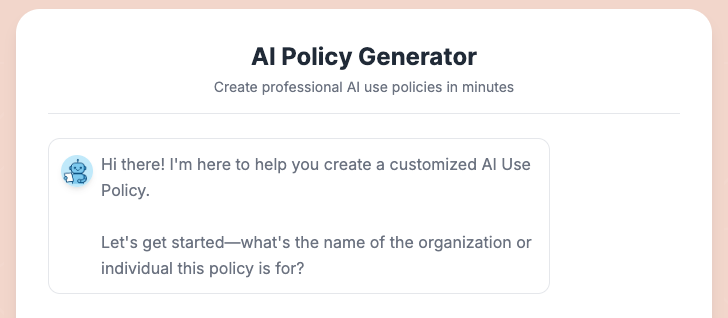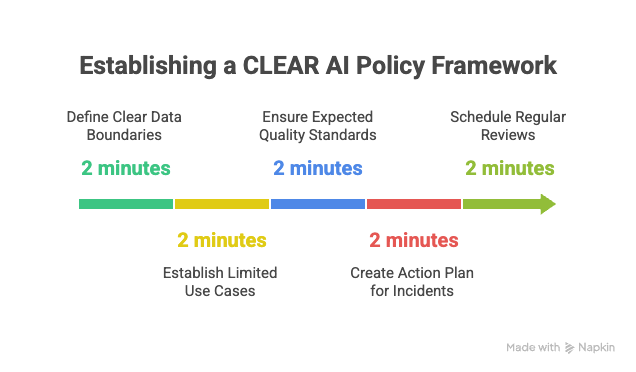Protect Yourself from AI Disasters in Just 10 Minutes
Your team is already using AI. The question isn't whether you need a policy, it's whether you'll create one before or after something goes wrong.
Thanks for reading! Join leaders worldwide who are future-proofing their leadership with Premium access to exclusive tools, direct guidance, and our leadership community. Discover what you're missing with a free trial.
PS: Many subscribers get their Premium membership reimbursed through their company’s professional development $. Use this template to request yours.
I’ve been thinking for some time now on whether or not there is a real risk in not having an AI policy in 2025, here is what I found.
Think of your organization like a house where someone just installed smart locks, a security system, and automated lighting throughout every room.
The technology works beautifully, doors unlock with a simple voice command, and lights adjust perfectly to the time of day. The security system learns your family's patterns and adapts.
But here's the problem: nobody wrote down the access codes, set the security rules, or established who can change the settings.
Your son figured out how to override the parental controls. The cleaning service accidentally triggered the alarm three times this week. And last Tuesday, a neighbor's kid somehow got the front door to unlock remotely using their tablet.
This is exactly what's happening with AI policy in most organizations today. Teams are using ChatGPT for communications, running data through AI tools for analysis, and automating processes with artificial intelligence. The technology works. It's helping.
But most leaders have no idea what guidelines exist, what data is being shared, or what happens when something goes wrong.
The window for proactive leadership is narrowing, but you're not too late. And you don't need months of committee meetings to get started.
I've created a solution for this exact challenge, an AI Policy Agent you can use today. More on that below.
The Hidden Opportunity: While Others Hesitate, You Can Lead
Here's what most leaders miss: while everyone is worried about AI risks, the real story is about competitive advantage.
Only 18% of organizations have established enterprise-wide AI governance councils (McKinsey, 2024), which means 82% of your competitors are flying blind. Meanwhile, organizations with comprehensive AI strategies demonstrate 80% success rates compared to just 37% for those without formal frameworks (IBM, 2024).
This isn't about complex compliance. It's about creating clarity that lets your team innovate confidently while others hesitate.
Why Smart Organizations Act Now
The landscape is shifting rapidly, but the opportunity window remains wide open for leaders who move strategically.
Current AI adoption has exploded: 78% of organizations now use AI (PwC Responsible AI Survey, 2024), but adoption without governance creates predictable problems, as you would expect.
But here's the twist: organizations avoiding AI policies aren't just being foolish, they're falling behind. These aren't just risks to avoid, they're competitive advantages to capture.
This opportunity won't last forever. Here's how to capture it:
The CLEAR AI Policy Framework
You don't need a legal team or months of planning. You need clarity on five essential areas that take minutes to establish and protect you from the majority of AI-related problems.
C - Clear Data Boundaries (2 minutes)
What data can be shared with AI tools? Create simple categories:
Green: Public information, marketing content, general research
Yellow: Internal processes, non-sensitive customer data (requires approval)
Red: Confidential data, personal information, proprietary systems (no AI sharing)
L - Limited Use Cases (2 minutes)
What AI tasks are acceptable? Define clear boundaries:
Encouraged: Content drafting, research assistance, data analysis
Requires oversight: Customer communications, financial processing
Prohibited: Final decision-making without human review, sensitive counseling
E - Expected Quality Standards (2 minutes)
How do you ensure accuracy? Establish review requirements:
All AI-generated content is reviewed before external use
Fact-checking for any statistical or technical claims
Clear attribution when AI assists with creation
A - Action Plan for Incidents (2 minutes)
What happens when something goes wrong? Create a simple process:
Who gets notified immediately?
How do you document and learn from mistakes?
What communications are needed (internal/external)?
R - Regular Reviews (2 minutes)
How do you stay current? Schedule quarterly reviews:
What new AI tools is the team using?
What policies need updating based on experience?
How are competitors and industry standards evolving?
This framework provides 80% of the protection with 20% of the complexity. You can implement it this week and refine it as you learn.
Organizations with clear AI policies don't just avoid problems; they accelerate innovation. Teams move faster when they know the rules.
Why This Matters to Me
I've spent years helping mission-driven leaders navigate the intersection of leadership and tech. Now, after watching too many organizations struggle with basic AI governance questions, I built the AI Policy Agent to make professional policy creation accessible to every leader and creator who wants to innovate responsibly.
Cost: The Price of 2 Cups of Coffee :)
Premium Subscribers: Get the AI Policy Agent for 30% off, the price of a cup of coffee, with the link found in the Premium Resource Hub.
If You Only Remember This
This isn't about limiting technology. It's about empowering leaders like you to use AI with confidence while staying true to your mission and values.
How the AI Policy Agent Works
After researching policies across industries and testing frameworks with dozens of organizations, I built the AI Policy Agent to make professional policy creation accessible to every leader.
The process is simple: Answer 8-10 guided questions about your organization, team size, industry, and risk tolerance. The agent generates a complete, professional AI policy tailored to your specific needs.
What you get:
Professional policy document ready for implementation
Industry-specific guidelines and examples
Signature section included
Clear language without technical jargon
Customized to your values and mission
Time investment: 10 minutes to answer questions, instant policy generation.
Research foundation: Built from analyzing effective policies across nonprofits, churches, businesses, and startups, incorporating current regulatory requirements and industry best practices.
For creators: 50% affiliate commissions are available for those who want to help their audiences create responsible AI policies.
If You Only Remember This
The organizations avoiding AI policies aren't being cautious; they're falling behind.
Your team is already using AI, so the question is whether you have guidelines or you're hoping nothing goes wrong
The CLEAR framework provides 80% of protection with minimal complexity or bureaucracy
AI without policies isn't innovation, it's gambling with your mission
What's Your Next Step?
What's your biggest AI policy concern right now? I'd love to help you think through it.
Let’s Connect
I love connecting with people. Please use the following connect, collaborate, if you have an idea, or just want to engage further:






Having the right policy in place for your organisation is absolutely vital to prevent blowbacks down the road. Especially using the commercial model of ChatGPT and (god forbid) prompting it with sensitive PII data of your customers.
There is a big difference between having a policy and adherence. People will find it increasingly hard to memorise the things they can do readily in their ordinary lives are prohibited in the workplace. An idea would be enhance the policy with a forecast of likely adherence and points where policy is likely to be breached because it is too complex or the delta between the policy and everyday usage becomes too big to be tenable.